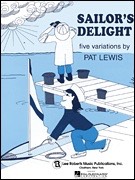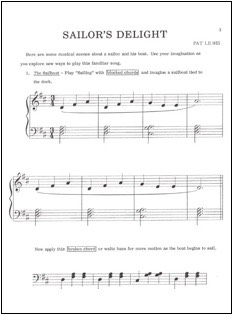
Foreword to
Sailor’s Delight
The purpose of Sailor's Delight "is to broaden the student's understanding of improvisational and compositional technics as he or she explores new tonal combinations and patterns as accompaniment to a known melody. Each student can then apply these improvisation possibilities to any number of familiar melodies.
It is hoped that the story setting will stimulate the student's imagination so that he or she will bring to music other ideas which are all around the student. Students can translate sound and ideas which are part of their life (whether it be everyday or imaginary) into the sounds which are possible on the keyboard.” — Foreword
By Pat Lewis
Imaginative exploration of block chords, waltz bass, tone clusters, parallel triads, varying registers, phrygian mode, and meter change through a set of simple variations.
––––––––

This set of variations on the tune, "Sailing" (from Music for Piano Bk 1, pg. 31) offers beginning piano students an example of the endless creative possibilities for varying a theme. Students can follow the simple instructions to play each variation and then create new ones of their own. The theme is introduced with a basic block style 1 and V7 harmonization that depicts a "sailboat tied to the dock." Next, the "Sailing" melody is accompanied with a waltz bass, "for more motion as the boat begins to sail." The succeeding variations move through a Sailor's Dance, Ship's Bells, Calm Sea, Stormy Sea, and Homeward Bound. Musical devices students will encounter, include tone clusters, parallel triads, varying registers, the phrygian mode, and a meter change from 3/4 to 4/4.
Technically and musically, these pieces provide good practice in balancing melody and accompaniment. Students who have difficulty doing this may find it helpful to get a sense of the hands playing two different dynamic levels simultaneously, by playing the melody, a few times, while only partially depressing the keys for the accompaniment.
Excerpted from TEACHING TIPS, by Cynthia Pace, Ed.D. © All Rights Reserved.
